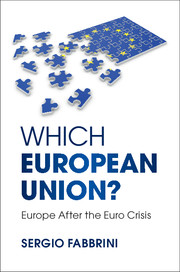Book contents
- Frontmatter
- Dedication
- Contents
- List of boxes
- List of figures
- List of tables
- List of abbreviations
- Preface – How many unions?
- Acknowledgments
- Part I Institutionalization of multiple unions
- Part II Main perspectives on the European Union
- 4 The perspective of the economic community
- 5 The perspective of intergovernmental union
- 6 The perspective of parliamentary union
- Part III Towards the compound union perspective
- Appendix
- Glossary
- References
- Index
5 - The perspective of intergovernmental union
Published online by Cambridge University Press: 05 March 2015
- Frontmatter
- Dedication
- Contents
- List of boxes
- List of figures
- List of tables
- List of abbreviations
- Preface – How many unions?
- Acknowledgments
- Part I Institutionalization of multiple unions
- Part II Main perspectives on the European Union
- 4 The perspective of the economic community
- 5 The perspective of intergovernmental union
- 6 The perspective of parliamentary union
- Part III Towards the compound union perspective
- Appendix
- Glossary
- References
- Index
Summary
The reform of Europe is not a march towards supra-nationality … The crisis has pushed the heads of state and government to assume greater responsibility because ultimately they have the democratic legitimacy to take decisions … The integration of Europe will go the intergovernmental way because Europe needs to make strategic political choices.
Nicolas Sarkozy, President of the French Republic, December 1, 2011Introduction
The intergovernmental perspective on the EU emerged during the negotiations that led to the 1992 Maastricht Treaty, to then acquire the form of a specific constitutional model or decision-making regime. The intergovernmental constitution was fully institutionalized by the 2009 Lisbon Treaty. Since financial policy has been assigned, by the latter, to the control of the intergovernmental constitution, the euro crisis has been a formidable test of its capability (Dinan 2011). Indeed, once the EU had to face the failure of the CT in the French and Dutch popular referenda of 2005, the intergovernmental perspective emerged as the predominant view of integration. As The Economist's Charlemagne (2012) wrote, after “the French and Dutch voters killed the proposed EU constitution … intergovernmentalism [became] the new fashion.” The view expressed by the then French President Sarkozy in his Toulon speech on December 1, 2011, that “the integration of Europe” will have to go the intergovernmental way if Europe wants “to make strategic political choices,” was and continues to be shared by several national governments and groups of citizens.
This intergovernmental perspective is not skeptical of the European integration process, as is the view of the supporters of the economic community. Post-Maastricht intergovernmentalism has recognized that integration should proceed without, however, going in the supranational direction. On the contrary, integration should consist in pooling national sovereignties within intergovernmental institutions. The decision-making power should not be in the hands of each member state, but in those of the institutions that coordinate the action of the member state governments (the European Council and the Council).
- Type
- Chapter
- Information
- Which European Union?Europe After the Euro Crisis, pp. 124 - 152Publisher: Cambridge University PressPrint publication year: 2015



